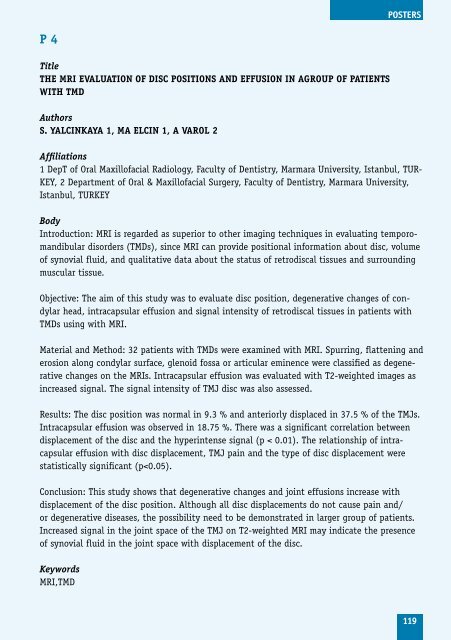Program including abstracts as pdf available here
Program including abstracts as pdf available here
Program including abstracts as pdf available here
You also want an ePaper? Increase the reach of your titles
YUMPU automatically turns print PDFs into web optimized ePapers that Google loves.
P 4<br />
Title<br />
THE MRI EVALuATION OF DISC POSITIONS AND EFFuSION IN AGROuP OF PATIENTS<br />
WITH TMD<br />
Authors<br />
S. yALCINKAyA 1, MA ELCIN 1, A VAROL 2<br />
Affiliations<br />
1 DepT of Oral Maxillofacial Radiology, Faculty of Dentistry, Marmara University, Istanbul, TUR-<br />
KEY, 2 Department of Oral & Maxillofacial Surgery, Faculty of Dentistry, Marmara University,<br />
Istanbul, TURKEY<br />
Body<br />
Introduction: MRI is regarded <strong>as</strong> superior to other imaging techniques in evaluating temporomandibular<br />
disorders (TMDs), since MRI can provide positional information about disc, volume<br />
of synovial fluid, and qualitative data about the status of retrodiscal tissues and surrounding<br />
muscular tissue.<br />
Objective: The aim of this study w<strong>as</strong> to evaluate disc position, degenerative changes of condylar<br />
head, intracapsular effusion and signal intensity of retrodiscal tissues in patients with<br />
TMDs using with MRI.<br />
Material and Method: 32 patients with TMDs were examined with MRI. Spurring, flattening and<br />
erosion along condylar surface, glenoid fossa or articular eminence were cl<strong>as</strong>sified <strong>as</strong> degenerative<br />
changes on the MRIs. Intracapsular effusion w<strong>as</strong> evaluated with T2-weighted images <strong>as</strong><br />
incre<strong>as</strong>ed signal. The signal intensity of TMJ disc w<strong>as</strong> also <strong>as</strong>sessed.<br />
Results: The disc position w<strong>as</strong> normal in 9.3 % and anteriorly displaced in 37.5 % of the TMJs.<br />
Intracapsular effusion w<strong>as</strong> observed in 18.75 %. T<strong>here</strong> w<strong>as</strong> a significant correlation between<br />
displacement of the disc and the hyperintense signal (p < 0.01). The relationship of intracapsular<br />
effusion with disc displacement, TMJ pain and the type of disc displacement were<br />
statistically significant (p


